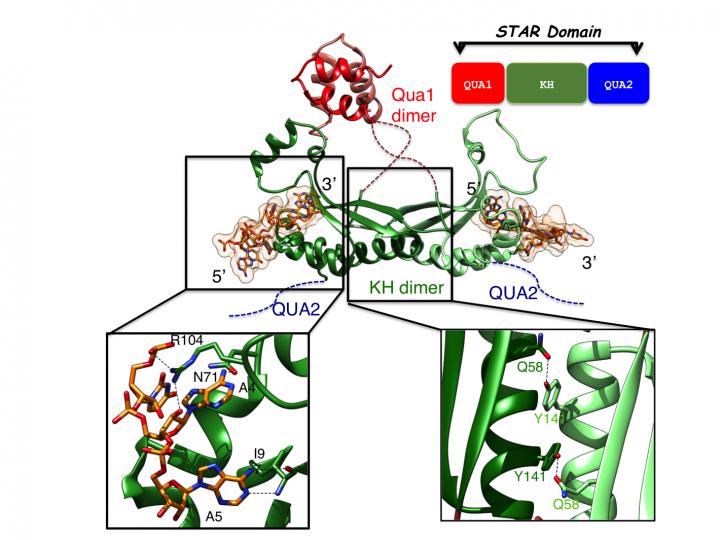New study creates first 3-D vision of cancer target

Top: Overview of the structure of T-STAR STAR domain in complex with AUUAAA RNA. Bottom left: close up view of the specific recognition of the RNA. Bottom right: close up view of the KH dimerization interface. Credit: University of Leicester
A team from the University of Leicester has for the first time published a detailed description of a protein linked to many types of cancer.
The lab-based study from the Department of Molecular and Cell Biology now provides an opportunity for scientists to develop drugs to target this protein.
Dr Cyril Dominguez who led the work at Leicester said: “My research field is structural biology. The proteins that we have studied, called Sam68 and T-STAR, are very similar and overexpression of Sam68 has been shown to correlate with poor prognosis in many types of cancers.
“Our results provide atomic resolution details on how Sam68 binds specifically to its RNA target. Furthermore, we show that Sam68 forms a homodimer that has never been described before and is crucial for its function in RNA splicing.
“This is important because this basic research set the grounds for structure-based drug design approaches. If we can identify or design drugs that bind specifically at the dimerization interface, we will be able to prevent the function of these proteins in cells, which could have implications for novel cancer treatments.
“Now that we have a high-resolution structure of Sam68 and T-STAR and a high-throughput binding assay, we are in discussion to collaborate with a major drug discovery consortium to screen a very large library of compounds to inhibit the function of Sam68.”
Dr Dominguez's work has been published in Nature Communications. He said: “Thanks to an MRC Career Development Award, I started my own research lab in 2010, and we were in competition with other well-established laboratories. This article is therefore the consecration of our hard work during the last five years.”
###
The work has been funded by an MRC Career Development Award to Cyril Dominguez (G1000526) that started in October 2010 and finished in September 2015, and a studentship from the College of Medicine, Biological Sciences and Psychology of the University of Leicester. This work is the result of a very fruitful collaboration with the groups of Professor David Elliot (University of Newcastle), Professor Michael Sattler (Helmholtz Zentrum Munchen, Munich) and Professor Ian Eperon (University of Leicester).
It is published here: http://www.
You can also view a copy here: https:/
NOTES TO EDITORS
For more information, please contact
Dr. Cyril Dominguez
Lecturer
Department of Molecular and Cell Biology
University of Leicester
e: cd180@le.ac.uk
w: http://www2.
The Medical Research Council is at the forefront of scientific discovery to improve human health. Founded in 1913 to tackle tuberculosis, the MRC now invests taxpayers' money in some of the best medical research in the world across every area of health. Thirty-one MRC-funded researchers have won Nobel prizes in a wide range of disciplines, and MRC scientists have been behind such diverse discoveries as vitamins, the structure of DNA and the link between smoking and cancer, as well as achievements such as pioneering the use of randomised controlled trials, the invention of MRI scanning, and the development of a group of antibodies used in the making of some of the most successful drugs ever developed. Today, MRC-funded scientists tackle some of the greatest health problems facing humanity in the 21st century, from the rising tide of chronic diseases associated with ageing to the threats posed by rapidly mutating micro-organisms. http://www.
Media Contact
All latest news from the category: Life Sciences and Chemistry
Articles and reports from the Life Sciences and chemistry area deal with applied and basic research into modern biology, chemistry and human medicine.
Valuable information can be found on a range of life sciences fields including bacteriology, biochemistry, bionics, bioinformatics, biophysics, biotechnology, genetics, geobotany, human biology, marine biology, microbiology, molecular biology, cellular biology, zoology, bioinorganic chemistry, microchemistry and environmental chemistry.
Newest articles

A universal framework for spatial biology
SpatialData is a freely accessible tool to unify and integrate data from different omics technologies accounting for spatial information, which can provide holistic insights into health and disease. Biological processes…

How complex biological processes arise
A $20 million grant from the U.S. National Science Foundation (NSF) will support the establishment and operation of the National Synthesis Center for Emergence in the Molecular and Cellular Sciences (NCEMS) at…

Airborne single-photon lidar system achieves high-resolution 3D imaging
Compact, low-power system opens doors for photon-efficient drone and satellite-based environmental monitoring and mapping. Researchers have developed a compact and lightweight single-photon airborne lidar system that can acquire high-resolution 3D…





















